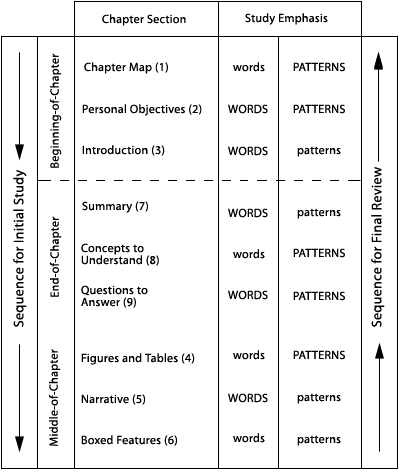This exceprt is taken from the "Preface" of my Information Systems textbook. Since I was swinging over to the intuitive end of the spectrum after years being anchored on the rational end, these study suggestions emphasized an "integrated, top down" approach. Added emphasis appears in red: (Note 121)
Many students find they can grasp the material more efficiently and effectively by studying the chapter sections in a different order than in the outline above. They take advantage of the special features of each section , in a "top down" and "integrated" approach to the subject. Top down means to begin with the broader view and gradually to work into the detailed presentation. Integrated means to use left and right hemisphere human information processing skills.
The table below describes a chapter study sequence that offers top-down, integrated advantages. (The number in parentheses is the order of the section in the traditional book sequence.) The general approach is to start with the first three sections of the chapter, then to study the three sections at the end before returning to the main chapter material. This direction is highlighted by the arrowheads on the left side of the table.

The discussion of human information processing in Chapter 2 provides the rationale for the study emphasis indicated in the two right-hand columns of the table. The left hemisphere of our brain specializes in word processing, and the right, in pattern processing. After you are accustomed to the suggested emphasis, you are likely to achieve two results: (1) efficient processing of the material and (2) effective comprehension of the assignment. Successful use of the study guidelines means that you will probably learn more in the same or shorter period of time than with your customary study habits.
Developing a skill in pattern emphasis typically represents the most difficult part of the guidelines. Pattern emphasis means that you focus attention on the arrangement of the material. An awareness of relationships among the ideas provides the brain with a framework for organizing and retaining the details of the material. For instance, the Chapter Map is a flow diagram identifying the major chapter topics and subtopics, and how they are related to each other. This pattern is more important than the words at this early stage in the top down, integrated approach to study.
In a largely preconscious manner your brain absorbs the pattern that makes it possible to pull together many individual items of the chapter coverage. Even though the chapter sections that indicate a pattern emphasis in the table do not seem to assist your study consciously, stick with trying to visualize the pattern wherever it is capitalized in the table. Since pattern processing draws on right hemisphere skills, it will not have the same conscious impact as your more familiar left hemisphere concentration on words.
Some students vary the order of the coverage suggested in the table to suit their own taste. However, in the long run most students find that the recommended sequence offers the most efficient and effective study method. In reviewing for examinations many students reverse the sequence in the table working from the "bottom-up" i.e., Boxed Features to Chapter Map. As the right-hand arrowheads in the table suggest, this reversed sequence emphasizes studying detail first, with generally higher levels of summary as you work up to the top of the table. . . .
Although technical in many respects, the study of information systems and their supporting computers in organizations is a fascinating subject. This technology and its implications permeate our society. An understanding of the subject enables us to participate more meaningfully in our careers and helps us to guide the development of people centered policies for the use of computers in society. Good luck in developing your acquaintance with the computer's use in organizations and its role in society!